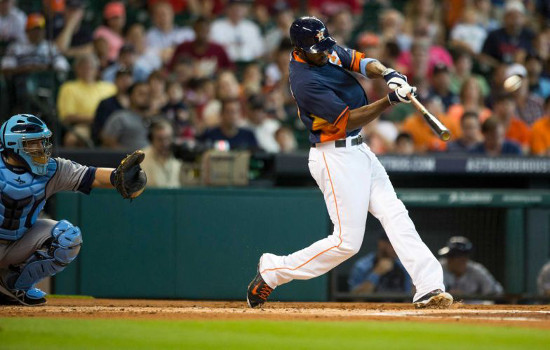Fowler’s selective tunnel vision paying off for Astros

By Evan Drellich —
Lost amongst Springleton mania and King Keuchel’s ascension might be the center fielder. Dexter Fowler can become a free agent after next season, so just how long he’ll be around is up in the air.
If he keeps playing this way, he’ll earn himself quite a haul, possibly too great a haul for the small-market-acting Astros to keep around. But that’s a story line to watch more in 2015, not this year.
For now, Fowler is one of the Astros’ best contributors, but his effectiveness isn’t as alluring as, say, George Springer’s. Fowler’s .389 on-base percentage entering Monday’s day off stood as the 15th-best mark in the majors and second best in the American League West behind Shin-Soo Choo of the Rangers (.394).
Since Fowler’s first full season in the majors, 2009 with the Rockies, he’s in the top 30 of all players in OBP. He’s always had a good batter’s eye – throughout the minors, too.
From where does it come?
“My dad always used to tell me get a good pitch to hit,” the 28-year-old from Georgia said. “You don’t get it, don’t swing. That’s what I was always taught since the beginning.
“You start at the beginning. Anything you start from the beginning, you get obviously pretty good at it. Most guys, they just want to go up there and hit.”
Eye surgery helps
There’s a physical component, too. Fowler said he has really good vision, helped by a Lasik procedure in 2008.
“It was definitely helpful, but I mean, even before that – I got called up in ’08 – but before that, my vision was always pretty good,” Fowler said.
Hard work is always the prescription for improvement, but when it comes to an ability to control and judge the strike zone, there’s something innate that Fowler and similar players have.
“I don’t think innate’s the right word,” Astros hitting coach John Mallee said. “I was a hitting coordinator for 10 years with the Marlins. You go back, and you look at the history of the guy prior to maybe getting into professional baseball, and we had a lot of guys that swing and miss. … You go back and look at their college numbers, and it was the same way.
“So we try to work on getting them a better pitch to hit, having a better plan in the box do a lot vision drills, a lot of vision-training stuff, and most people have it or they don’t, a lot of times. I think that (Fowler has) always been a guy that has had that unique ability to recognize (pitches) early out of the hand. Some guys see trajectory, where other guys see spin, and I think he sees a combination of both. Because really, the only time he expands out of the zone is when he gets too anxious because he wants to hit so bad.”
Fowler said the same thing: Sometimes that itch to swing the bat can be hard to resist, even for an experienced batter. Little Leaguers aren’t the only ones who battle that.
“Yeah, I get mad sometimes,” Fowler said. “Like, I’m patient with the umpires. But when I do argue, I’m pretty sure that I know I got it. I argued (in May), and I got it right. I know I got it right. … He apologized.”
Advance scouting reports have become increasingly complex in the majors as available data has proliferated. Teams meet before every series to discuss upcoming opponents, and every tendency is available for hitters and pitchers alike to study.
It doesn’t seem Fowler was attempting to be modest. He really just doesn’t need that much help.
“He just wants to know the velocities of the pitches and … ‘How does this guy try to get people out? What’s his out pitch?’ ” Mallee said. “His philosophy is, ‘I hit what I see.’ ”
Said Fowler: “I don’t do much. I just need to know velo. I need to see how it moves, and that’s about it. People ask me that all the time. They’re all like, ‘How do you take that pitch?’ I don’t know.”
Tailored lesson plans
Mallee, an unheralded addition to the Astros who can impart a world of information on anyone in just a few minutes, dove into the types of learning: audio, visual and kinesthetic. When he addresses his players, he knows who responds to which types of lessons.
Fowler is a kinesthetic learner, and every hitter needs maintenance work. A switch-hitter, Fowler has to work to keep his posture proper when batting lefthanded.
“He struggles a little bit with the ball in, and he’s gotten lot better with that just by adjusting his own posture,” Mallee said. “Righthanded, he doesn’t do that. It causes him to pull off the ball lefthanded, get topspin to his pull side.
“Getting to know him now, he hears me, but he needs to feel it,” Mallee continued. “So we put him in drill situations to feel what he heard. And he does a very good job of self-adjusting, because he knows his body and he knows his swing. And when he gets in trouble, it’s usually one or two things, and he knows how to fix it.”
Fowler can still leave a lot of other people puzzled, though.
“I used to play with (catcher Chris) Iannetta,” Fowler said. “And it was funny, ’cause Garrett Richards was pitching, and I guess he threw me a slider like down, down and in. Started like middle away. And (Iannetta) was like, ‘How do you take that?’ ”
